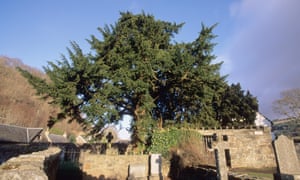The Fortingall yew in Perthshire has started to produce red berries, suggesting a change of sex in one of its branches. It’s an unusual – but not unprecedented – switch

After possibly 5,000 years alive, doing anything other than dying would be a surprise. But Britain’s oldest tree is very much alive – and has amazed observers by apparently changing sex.
Fortingall yew in Perthshire is justly famous as one of the oldest living things in Europe, although no one knows its true age because its most ancient parts have decayed and disappeared.
The sprawling tree is male, producing small spherical structures that release pollen, unlike the female yews, which produce the more familiar bright red berries. But on a recent visit, Max Coleman of the Royal Botanic Garden, Edinburgh, found three red berries on the tree.
“Odd as it may seem, yews, and many other conifers that have separate sexes, have been observed to switch sex,” writes Coleman in his blog. “Normally, this switch occurs on part of the crown, rather than the entire tree changing sex. In the Fortingall yew, it seems that one small branch in the outer part of the crown has switched and now behaves as female.”
A botanist first noted a partial sex-change on a yew in Shropshire in 1837 but tree experts say it is still extremely unusual.
Many tree species contain both male and female parts (with systems to stop it pollinating itself) but some species, such as holly or yew, are usually only male or female. A few species, such as ash, routinely switch sex, producing male flowers one year and female fruits another. If a tree produces a large crop of seeds one year, it may switch the following year to male flowers to reduce the strain on itself.
Ancient trees can also create separate entities within their structure to protect themselves from disease. “It’s a strategy for longevity,” says Brian Muelaner, chair of the Ancient Tree Forum. “The Fortingall yew is fragmented and it may be so compartmentalised that part of it has become sexually ambiguous. We are all continuously learning about ancient trees – the ageing process of trees is a new science.”
Tree lovers and scientists will now wait with baited breath: Coleman picked the three berries, which have been sown in pots. If they germinate next spring, the Fortingall yew will produce its first identifiable offspring in perhaps thousands of years.

